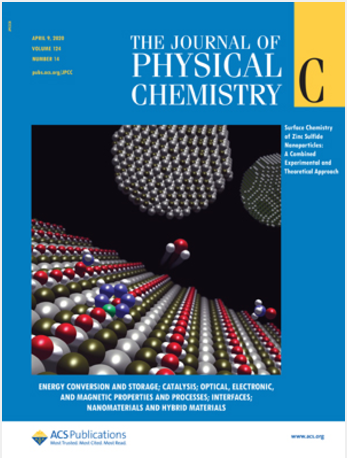IF 3.3
3区 化学
Q2 CHEMISTRY, PHYSICAL
引用次数: 0
摘要
光电化学(PEC)还原二氧化碳以生产燃料和有价值的化学品(如 CO、CH4、CH3OH)已受到广泛关注。PEC CO2 还原通常在高浓度碳酸氢盐(HCO3-)溶液中进行。最近,在对型氮化镓(Au/p-GaN)上支持的金纳米粒子显示出在可见光条件下产生 CO 的卓越选择性。选择性的一个决定性因素可能是电解质效应。迄今为止,关于 HCO3- 在 PEC CO2 还原过程中的作用(如质子供体、碳源),已经提出了一些有争议的模型。了解电解质的作用对于控制产物选择性至关重要。然而,只有少数研究探讨了 HCO3- 在 PEC CO2 还原过程中的表现。在本研究中,我们应用原位表面增强拉曼光谱(原位 SERS)研究了 Au/p-GaN 催化剂上 PEC CO2 还原过程中 HCO3- 在表面附近的行为。源于 HCO3- 的双齿碳酸盐 (CO32-) 的量在一定电位(-1.3 V 对 Ag/AgCl)下达到最大值。作为 PEC CO2 还原产物,CO 和 CH4 的产生取决于所施加的电位。双齿 CO32- 的电位依赖性与产生 CH4 的选择性有关。我们的研究结果表明,HCO3- 通过吸附 CO32- 和捐赠质子,在提高 CH4 对 CO 的选择性方面发挥了作用。本文章由计算机程序翻译,如有差异,请以英文原文为准。

In Situ Vibrational Spectroscopic Study for Photoelectrochemical CO2 Reduction over the Au/p-GaN Catalyst: The Role of HCO3– for Selective Reaction
The photoelectrochemical (PEC) reduction of CO2 has been paid much attention to produce fuels and valuable chemicals (e.g., CO, CH4, CH3OH). PEC CO2 reduction is generally performed in solutions with a high concentration of bicarbonate (HCO3–) solutions. Recently, gold nanoparticles supported on p-type gallium nitride (Au/p-GaN) exhibited superior selectivity for CO production under visible-light conditions. A determining factor for selectivity could be electrolyte effects. So far, some controversial models have been proposed for the role of HCO3– involved in the PEC CO2 reduction (e.g., proton donor, carbon source). Understanding the role of electrolytes is crucial for controlling the product selectivity. However, only a few studies have addressed how HCO3– behaves in PEC CO2 reduction. In this study, we applied in situ surface-enhanced Raman spectroscopy (in situ SERS) to investigate the behavior of HCO3– near the surface during the PEC CO2 reduction on Au/p-GaN catalysts. The amount of bidentate carbonate (CO32–), which originates from HCO3–, takes a maximum at a certain potential (−1.3 V vs Ag/AgCl). Both CO and CH4 are produced depending on the applied potential as the PEC CO2 reduction products. The potential dependence of bidentate CO32– can be correlated to the selectivity of CH4 production. Our results suggest that the HCO3– plays a role in improving the selectivity of CH4 over CO via the adsorption of the CO32– and donation of protons.
求助全文
通过发布文献求助,成功后即可免费获取论文全文。
去求助
来源期刊

The Journal of Physical Chemistry C
化学-材料科学:综合
CiteScore
6.50
自引率
8.10%
发文量
2047
审稿时长
1.8 months
期刊介绍:
The Journal of Physical Chemistry A/B/C is devoted to reporting new and original experimental and theoretical basic research of interest to physical chemists, biophysical chemists, and chemical physicists.
 求助内容:
求助内容: 应助结果提醒方式:
应助结果提醒方式:


